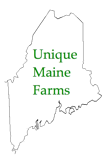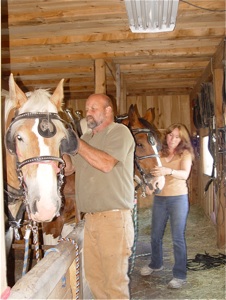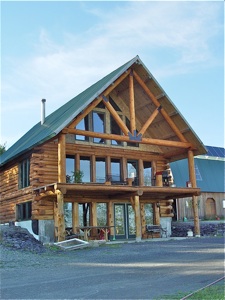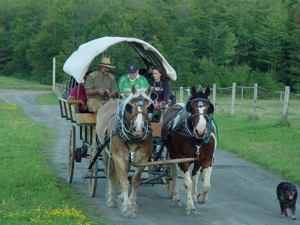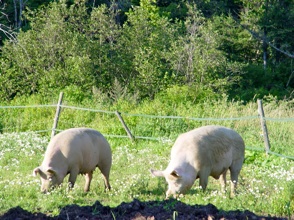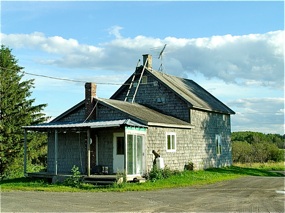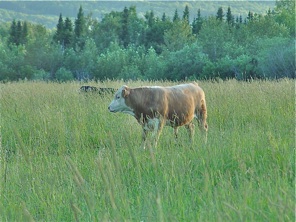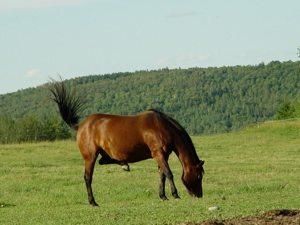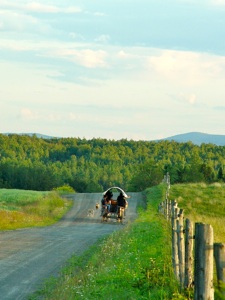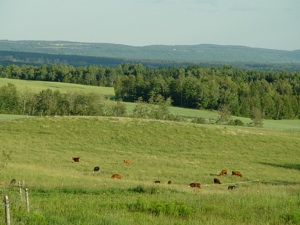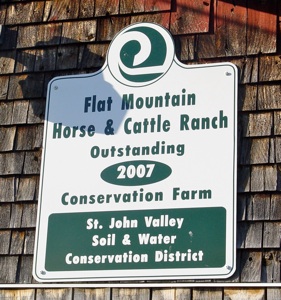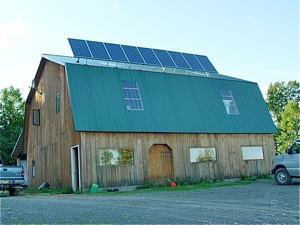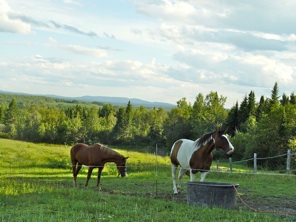Name: Flat Mountain Horse &
Cattle Ranch
Address: John and Ann Babin
168 Bouchard Road
St. Agatha, Maine 04772
Phone: 207-543-9341
207-249-1162
Email: annbabin7@gmail.com
Products and Services:
-beef
-hay
-horses for sale
-horse-drawn covered wagon rides either
around the farm or off-site
What Makes Flat Mountain Horse & Cattle Ranch Unique?
When people discuss “The County” (the area in Maine that makes up Aroostook County) there usually are references to its exceptional natural beauty, the friendliness of the people, the extensive farmland, its rich history, and its distant location from many areas in the state. A visit to John and Ann Babin’s Flat Mountain Horse and Cattle Ranch in St. Agatha is a great example of aligning well with the common characteristics of the region. Like so many of the farms in “The County,” the Flat Mountain Horse and Cattle Ranch is truly quite special in its own particular way.
Although John hailed from Fort Kent, and Ann was from Frenchville, a common love for horses brought them together. In 2001, they purchased the old farmhouse on Bouchard Road (formerly called the Fourth Row). The house was in very poor condition, but they knew that the ninety acres surrounding it was a perfect spot to establish a horse and cattle ranch.
At the present time, the Babins are caring for sixteen horses. They have two teams of horses including a team of spotted draft horses and another pair of Belgians. They also are home to Paints and ponies. Some of their horses are old and the Babins simply wish to give them a good home. Four or five of the horses are used for pleasure riding. The Babins often have horses for sale.
In the past Ann used to conduct many horse training clinics. She still helps train horses on occasion. She is the President of the Acadian Trailriders Association and she has been working with other pleasure riders to plan a two-week trail ride across Maine, New Brunswick, and Quebec. She presently is working as an educational technician at the local elementary school.
John and Ann have both dedicated a great deal of time making improvements at their farm. The old farmhouse that they purchased proved to be too costly to renovate. They lived in it from 2001 until 2012. During the last three years of residing there, they were busy building a new house on a much more highly-elevated section of their land.
John had to build a road to the new location and they harvested all the wood used in the building. A solar system with generators as back-up is the Babin’s source of power. The design of the two-and-a-half story house incorporated massive timber beams, a high cathedral ceiling and an abundance of large glass windows to enjoy the spectacular views of the surrounding farmland and mountains and vistas of Eagle Lake, Square Lake, and Cross Lake.
John is skilled in many trades beyond the construction of buildings and houses. He built the beautiful covered wagon that accommodates between twelve to fourteen passengers. John and Ann conduct horse-driven wagon rides around their farm for various groups. They also bring the covered wagon to weddings, special events, and parades that take place off the farm. On the day that Unique Maine Farms visited the Babins they were hosting a group of teachers from the Marshall Islands. The outing was planned by Ellia Sablan-Zebedy, the Dean of Enrollment Management at the University of Maine at Fort Kent. The teachers enjoyed taking a ride in the covered wagon and touring the farm. Ellia very kindly shared some
reflections of the field trip to the Babin’s farm and the program that the teachers were studying and they can be accessed on a webpage included in this profile.
In addition to leading wagon rides, John used to keep busy with farrier work, but his back no longer allows for that. A farrier now comes to shoe the horses at the farm in trade for hay. Harvesting hay at the farm is a lot of work. The Babins harvest between 1600-2000 round bales and about 5000 square bales. They sell hay and also keep plenty to feed their horses and the twenty Hereford-cross cattle that they raise. They sell their beef by the side.
What started out as a horse and cattle ranch, soon evolved into quite a diverse farming operation. The Babins were a recipient of a Natural Resources Conservation Services’ grant which enabled them to erect a large hoop house on the farm to extend their season for growing vegetables. They have two dairy cows and their milk is collected for personal use. The eggs from the chickens and the pork from the pigs that they raise are also consumed at the farm. Both Ann and John have worked at various jobs to meet some of the farm expenses. In the winter, John plows snow in the area.
The Flat Mountain Horse & Cattle Ranch was recognized with the Outstanding Conservation award by the St. John Valley Soil and Water Conservation District in 2007. Steve Cashman, a soil conservationist with the St. John Valley Soil & Water Conservation District, explained that the Babins have introduced many innovative farming practices. To better handle the waste stream from the animals they built a system with concrete and mounds of dirt that enable them to clean up after the animals more easily in the winter months. Several manure storage areas have been established at Flat Mountain Horse and Cattle Ranch. They also introduced no-till seeding. Their water systems are solar-powered. At the present time they are working on a composting system.
Unique Maine Farms is also looking forward to sharing information about some of the fascinating agricultural history specific to the Flat Mountain region of Saint Agatha where the Babin’s farm is located. When John and Ann Babin purchased the farm in 2001, they moved into the old farmhouse that was situated on Bouchard Road, but was formerly called the “Fourth Row” in the area commonly known as the “Concessions.”
Roger Morneault kindly spent quite a bit of time explaining that farming in the Flat Mountain area used to be a major occupation for many people. Roger is a fifth-generation resident of the Flat Mountain region and very interested in its history. According to Roger, there were four roads in the area around 1900, that were numerically named First Row, Second Row, Third Row, and Fourth Row.
There were so many children in the Flat Mountain area in the early 1900’s, according to Morneault, that there were actually six one-room schoolhouses built in the area. By law, education had to be provided. Since the roads in the winter at that time were so difficult for travel it was determined that no child should have to walk more than a mile
to school.
During the early days, most of the farms were potato and subsistence farms. With the introduction of mechanization, many of these small farms declined and many residents moved away. Electricity was not even introduced into the Flat Mountain area until 1948! The six small one-room schoolhouses were actually dismantled in 1948, and physically transported to downtown Saint Agatha and combined to form the Montfort School which educated students from kindergarten through sixth grade. It served students until 1978, when it was closed. The building was demolished in the early 1980’s.
The old farmhouse, which the Babins purchased in 2001, offers such a striking contrast to the large, modern, solar-powered residence that they constructed and now occupy high on the ridge. The old farmhouse serves as a great reminder of the farms that used to operate in the area. Families may have moved away, but their fondness and allegiance to the area and the land has, in many cases, remained very strong. When a Flat Mountain Reunion was held in 2010, in conjunction with the Long Lake Summerfest, over five hundred people showed up to enjoy the reminiscing and festivities. How fitting that John and Ann Babin provided horse-drawn wagon rides during the Flat Mountain Reunion as they have established themselves as contributing members of the Flat Mountain area farming community.


